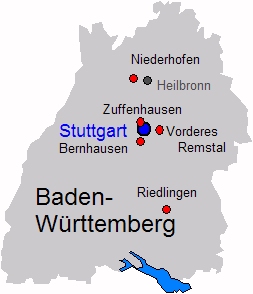|

The history of Baden-Württemberg can be gathered from the homepage of this country (see below*). In extracts can be taken out:
Baden-Württemberg have evolved on the basis of a referendum. The majority of citizens resident in the three states of Württemberg-Baden, Württemberg-Hohenzollern and Baden voted in favour of a merger on December 16, 1951. The foundation date of Baden-Württemberg on April 25, 1952.
Until the "land consolidation of Napoleon" at the begin of the 19th century the German South West was the classical country of German "Kleinstaaterei" (sectionalism) with about 600 autonomous territories. Beside the larger secular territorial states as Palatinate, the Duchy of "Wirtemberg" and the county margrave of Baden these structures of small cultur consisted of episcopal territories as Konstanz, Basel, Straßburg, Speyer, Worms and Mainz, abbeys of the empire as Schöntal, Zwiefalten, Wiblingen, Rot at the Rot, Weingarten, Salem and Tennenbach as also territories of the "Deutschorden" as Mergentheim, Altshausen and Mainau.
Also Austria had wide possessions with the "vorderösterreichischen" territories from Black Forest, the five cities of Habsburg at the Danube, the county Hohenberg with Rottenburg, and parts of the Allgäu. Additional there were the principalities Hohenlohe, Hohenzollern, Waldburg, Fürstenberg, Thurn und Taxis as also numerous smaller counties and territories of imperial knights. Not at last there were alone 24 of the 51 imperial cities of the old empire on the teritory of the present Baden-Württemberg.
A part of these territories was protestant as the Palatinate, the margraviate Baden-Durlach, the Duchy of Württemberg and some imperial cities as Aalen. The other territories were catholic, in the imperial cities Biberach and Ravensburg Protestants and Catholics there was a parity, the means Protestants and Catholics were equal. According to the maxim of the Peace of Augsburg of 1555 - cuius regio, eius religio - each territorial prince could dictate their populations’s religion. As the colorful brindled the map of the dominions was also the map of religious denominations. Each of the predecessor states of the present Baden-Württemberg shows his own political and cultural traditions, which each came from the specific historical experiences. The special embossing force of the religious denomination comes along, which from one territory to the other had its special characteristic. Thus in Württemberg was an outstanding rigorous Protestantism with numerous special movements (Pietismus). Other regions as the "vorderösterreichischen" territories showed a live Catholicism.
In the map of Baden-Württemberg showed above the places or regions are indicated, which can be find within the family research of "Familienforschung Mörgenthaler". Only those ancestors in Württemberg were catholics, who came from the suroundings of Riedlingen/Danube, all other were protestants.
|